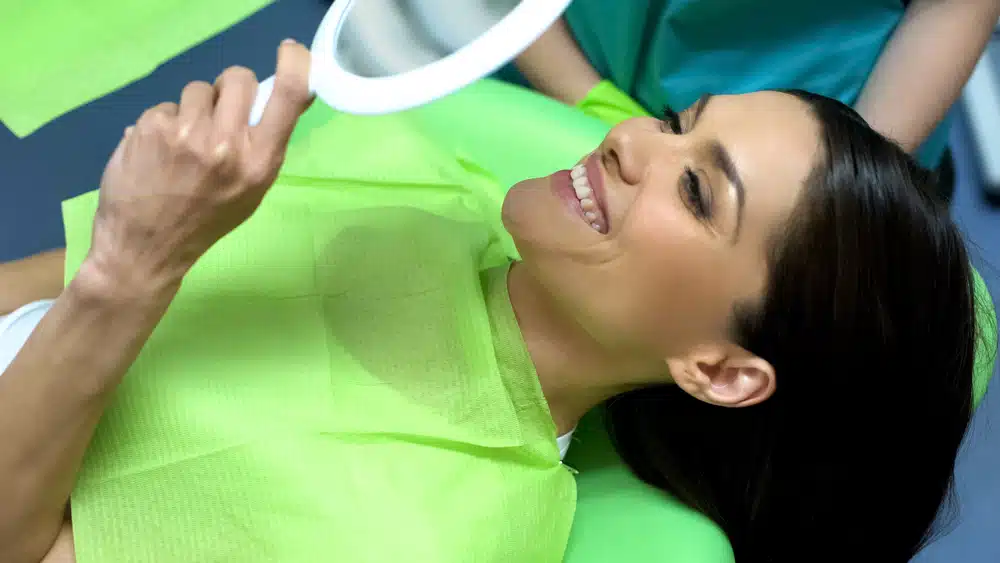Cosmetic Dental Procedures
Average treatment times: 30-90 min

What To Expect
There are many ways that dentistry can improve your smile — not just in terms of function, but also appearance. Here are a few of the most common ways dentists can help you.
In-office Whitening Bleaching products brighten teeth that have been stained or darkened by food, tobacco use, injury or aging. In-office bleaching takes place over a series of one-hour appointments at the office. First, your teeth will be examined and cleaned to make sure there are no cavities, loose fillings, gum problems or other issues that may be bothered by the bleaching process. A custom-fitted mouth tray will be made for you. A bleaching gel is then applied to your teeth in the tray.
Crowns Crowns are used to strengthen and improve the shape, size or color of teeth. They can support broken or weak teeth or those with large fillings. In the case of stained, misshapen, or otherwise abnormal teeth, they can create a smooth, strong and attractively contoured surface that is also stain resistant. Crowns also aid in the restoration of implants. When joined together to replace missing teeth, crowns are called bridges.
Porcelain Veneers Porcelain veneers are a fantastic way to repair or enhance the appearance of front teeth. They can be used to whiten teeth, close spaces and create a great smile. Using veneers, we can even perform virtually “instant orthodontics” to straighten crooked teeth and give you the bright smile you always wanted.
Tooth-Colored Fillings The back teeth can be noticeable when we talk and especially when we laugh. Seeing dark, unsightly areas of metal detracts from an otherwise perfect set of teeth. We have long had fillings available that are specially designed to match the natural color of the tooth. These directly placed, bonded resin fillings can make a tooth look like new, whether they are used for small areas of decay or to replace current fillings. In many cases, the newly-placed filling can be indistinguishable from your natural tooth structure.
Dental Implants The healthiest thing to do when you lose a tooth is to have it replaced. Otherwise, you risk problems with biting, chewing and speaking, headaches, muscle pain and an unattractive appearance. Fortunately, today, many patients can benefit from comfortable, secure, and natural-looking dental implants for tooth replacement. Dental implants serve as the base for many tooth-replacement options, including bridges, dentures and individual artificial teeth. Implants are surgically implanted in the jaw to provide a comfortable, secure fit and a natural look. In the first one or two appointments, the post or anchor is implanted in the jaw. Think of it as an artificial tooth-root. The replacement tooth, bridge or denture is then fitted and placed once the bone and gums have healed. From a maintenance standpoint, when you lose a tooth, a dental implant comes closest to copying the original in terms of care. Someone looking at an implant crown will usually have difficulty distinguishing it from the real thing. Surgery is sometimes performed in a periodontist’s office or it may be completed by an oral surgeon under local or general anesthesia. As more and more general dentists have received additional training in this procedure, it is becoming commonplace for the service to be provided by your family dentist.
Mini Implants Mini-implants are a great way to stabilize a loose or uncomfortable lower full denture. When a person has lost too much bone in their lower jaw, it can often be nearlyimpossible to wear a lower denture. In many cases, we can comfortably place these tiny implants in as little as one visit. An evaluation of your mouth is usually needed to be certain you are a candidate, but mini-implants can often be placed even in those cases where a traditional implant may not be an option.
Metal-Free Partial Dentures Are you tired of showing unsightly metal clips when you smile? How about a metal-free partial denture? Light-weight and durable, these dentures have the added benefit of being hypo-allergenic for people who have metal sensitivities.
Not sure what a word means? Consult this Dental Dictionary for complete descriptions of several dental terms that you may not be familiar with.
